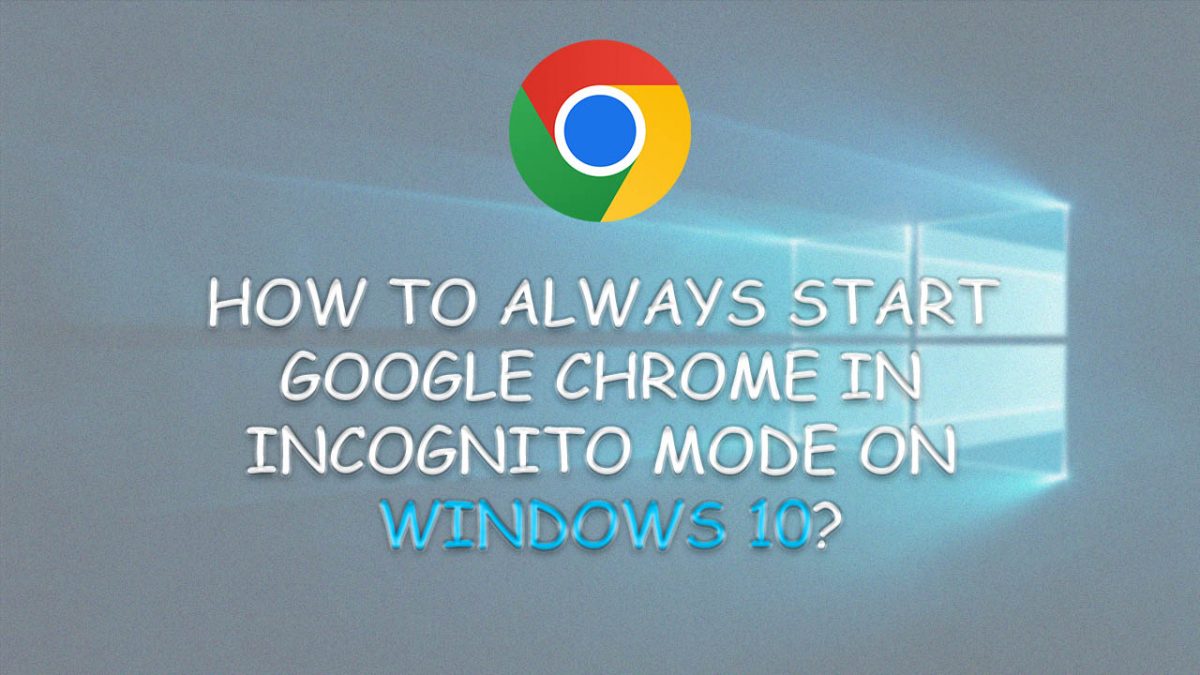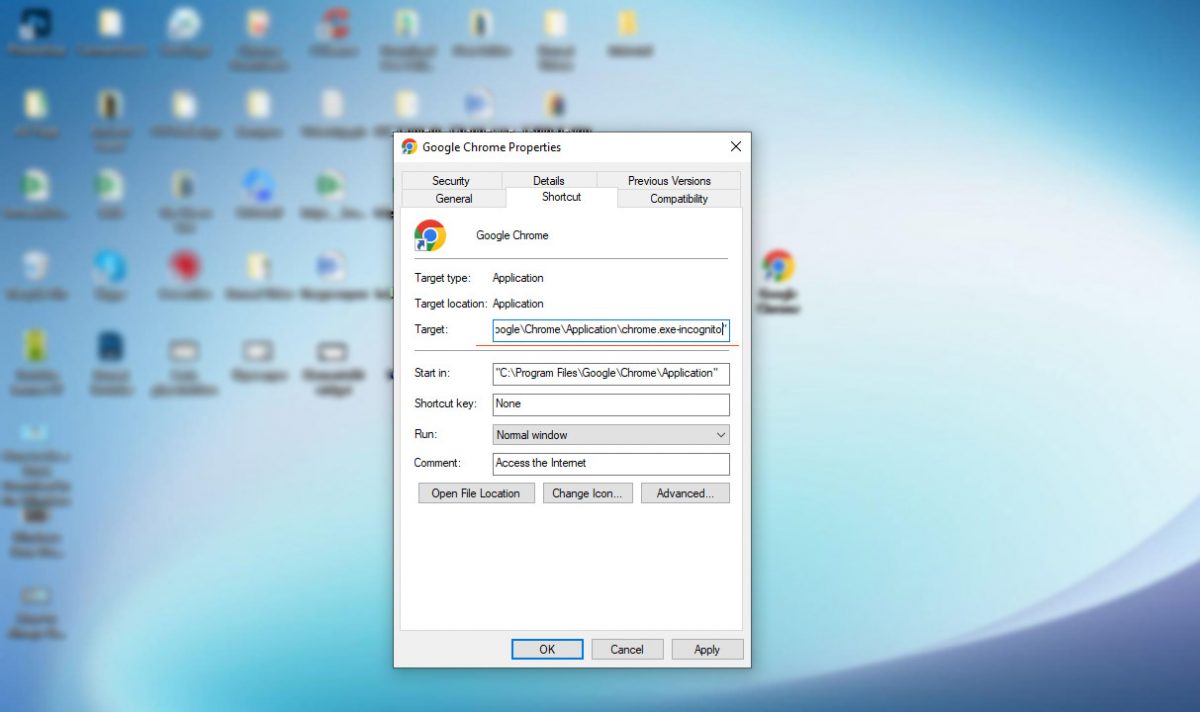How to Always Start Google Chrome in Incognito Mode on Windows 10?

One of the best things about using Google Chrome is it keeps track of your browsing history. However, many find this feature troublesome. Not all want to 'pick up where they last left off.' This is where incognito mode helps you. You can now set Google Chrome to open in incognito mode every time you launch it. Read on to learn how.
Incognito Mode
The incognito mode in Google Chrome is a private browsing mode. This mode disables local storage of site data, cookies, and browsing history. All data is wiped out, and the session ends when you close any Chrome windows. However, all bookmarks and downloads are saved unless deleted manually.
One misconception people have is their data is kept private when using incognito mode. You should know that you can still be tracked and attacked by third parties. Your ISP (Internet Service Provider) can track your browsing history and block local websites according to your geography.
Starting Google Chrome in Incognito Mode
To start Google Chrome in incognito mode, you will need to add a command line to the Chrome shortcut. While this may sound technical, it's easier than you can imagine.
You first need to locate the shortcut for Google Chrome. Most have this on their desktop, and some have it in their start menu. Right-click on it, and in the pop-up, click on properties.
In the properties window, click on the shortcut tab and click in the field next to target. The target box, by default, would have the chrome.exe path. You can modify this path by pressing the space bar and then typing "-ingonito" at the end of the text field.
The target box will now contain the path for chrome.exe with " -incognito" at the end. Click apply and then ok. Ignore the warning sign that pops up. The next time you launch Chrome, it will open in incognito mode. However, this will only happen if you launch Chrome using the shortcut you modified.

Removing Incognito Mode
If you want to stop Google Chrome from opening in incognito mode, remove the " -incognito" at the end of the path next to the target field.
The Dark Web Awaits
Getting into incognito mode may seem like a hassle every time; however, with this one simple step, you can now launch Chrome in this mode every time. It would help if you always remembered to stay safe and avoid entering personal data in unknown URLs. Incognito mode is not entirely safe, and your data may still be compromised.
Advertisement















Why use an incognito mode when you can use browsers with a pre-installed web proxy. The UtopiaP2P ecosystem browser is the best way for me to surf the web anonymously. If, like me, you value your anonymity and privacy, then I recommend using this browser.
“One of the best things about using Google Chrome is it keeps track of your browsing history.”
Considering the article topic I assume you mean browsing history in a broader sense, including things like tracking storage. Well even if that comment was restricted to browsing history only, not only it’s not Chrome specific but rather universal among browsers, but Chrome would instead be specific in making keeping history the worst possible feature among browsers. Because while most of the browsers (Chrome and Firefox for instance) misuse browsing history by exploiting it commercially for things like personalized advertising, so the more is kept the better for them, Chrome excels at it by uploading it unencrypted to Google servers often without the user even knowing.
“This mode disables local storage of site data, cookies, and browsing history.”
This is false. You are still being tracked by web sites (by local storage, cookies…) during your private browsing session, it just ends at the end of the session by a wiping of the tracking storage. Firefox has the same issue, and both by design. From:
https://support.google.com/chrome/answer/7440301
“Cookies and site data are remembered while you’re browsing, but deleted when you exit Incognito mode.”
In fact, if it works like in Firefox, the tracking storage is even hidden to the user in the UI during private browsing but still here, creating the illusion that it is actually disabled, and even technical users often fall for this. The ability to limit, clean, auto-clean tracking storage, for instance with extensions, may also be limited in this mode. Personally I do not use it because it’s not private enough for this reason, giving up control on cookies ; I use normal mode with privacy tweaks.
A consequence is that browsers like Tor Browser that use mandatory permanent private browsing mode suffer from the same problem. In fact some update went further and totally removed the ability to block cookies and other tracking storage in the UI, while it’s still possible in Firefox in private browsing.
In private browsing modes a bit like in Tor Browser it seems that there is an underlying philosophy that it doesn’t matter that you every tiniest action is being scrutinized, analyzed, and used back against you by evil actors as long as there isn’t your real life name attached to the process. Personally, I disagree. This “loophole” is being heavily abused by surveillance capitalists in many other ways currently.
“One misconception people have is their data is kept private when using incognito mode. You should know that you can still be tracked and attacked by third parties. Your ISP (Internet Service Provider) can track your browsing history and block local websites according to your geography.”
I don’t think that the most common misconception about private browsing is that it would act like an antivirus and block attacks that target vulnerabilities.
What’s often misunderstood is rather that a lot of this mode aims at protecting from other users of the same computer, being a sort of “porn mode” for example. From the same Google reference:
“When you browse privately, other people who use the device won’t see your history.”
A typical example being the browsing history wipe, while such history is not accessible to web sites anyway, but could be to other local users. (well as discussed above it’s also accessible to browser companies while it shouldn’t be, and additionally for anti-user purposes, but that’s another issue). Or the cookies being stored in memory instead of on disk, which may address yet other privacy issues due to local attacks.
However it is also useful to partly limit web tracking (I would not call this “third party” as the author writes because this obviously also includes first party ie the browsed site) in addition to protecting from other local users, by wiping tracking storage at the end of the session. With the caveat above that during the session itself, tracking storage is not disabled. There are also typically other measures that are directed against tracking by web sites exclusively, that are enforced in private browsing mode.
And finally there is all the tracking by sites that happens without using the tracking storage itself, such as through fingerprinting or the IP address ; wiping storage at the end of the session won’t help with that, unless using Tor Browser.
@Shaun thanks for the articles!
Question marks after a declarative sentence is bad Grammer. See the headline. To use a question mark simply change the wording to a sentence, such as “How do you……”
Or Brave shortcut with “-tor” parameter at the end.
The problem, is that I’m not sure which is less dangerous – Chrome or Tor?
Really Shaun your writing “The Dark Web Awaits!” is the dark mode the same as the dark web?
Maybe dark mode was a better title?
https://en.wikipedia.org/wiki/Dark_web
I guess Softonic is also getting money from Google.
I don’t think so. The real summary. If you need to use Chrome use it in Incognito Mode because it keeps track of your browsing history. Use Edge for your normal browsing. Edge keeps track of your browsing history for saving puppies:) Typical tricks, badmouthing the main competitor.
Wait till Shaun discovers chrome://flags/ and then the real how-to chrome article flooding will start…